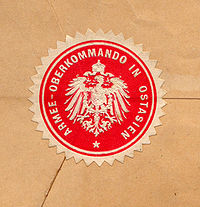|
Armeeoberkommando
Armeeoberkommando ("Army Higher Command"; AOK) was a command level in the German and Austro-Hungarian armies, especially during the World War I and World War II. It was equivalent to a British, French, American, Italian, Japanese, or Imperial Russian "Army".  World War IGermanyThe army of the German Empire had so-called Armee-Inspektionen ("Army Inspectorates") as the command authorities above army corps. These were numbered from I to VIII. During World War I, they were renamed to Armeeoberkommandos. Austria-HungaryIn Austria-Hungary an Armeeoberkommando (AOK) - there was only one - was established in summer 1914 at the outbreak of the war. It was the command center for all land and naval forces of the Dual Monarchy. It was led by the following Armeeoberkommandanten ("army commanders-in-chief"): Archduke Frederick; from 2 December 1916, Emperor Charles I himself; on 3 November 1918, Arthur Arz; 4-11 November 1918, Hermann Kövess. Its chiefs of general staff were: to 1 March 1917, Field Marshal Conrad; from 2 November 1918, Arthur Arz. The AOK was stationed in Teschen in Austrian Silesia until 1916, and then in Baden bei Wien. World War II During World War II, an AOK (usually commanded by a Generaloberst ("colonel general" or above) controlled several army corps and had its own army troops, e.g. heavy artillery, engineers, and other specialist troops that were subordinated to it depending on availability and task. The AOK was the command level between army group and corps. Demands and allocation of logistic supplies usually went straight to the Oberquartiermeister ("senior quartermaster") of the AOK; the army group command was only involved in situations of crisis. The area of responsibility of an AOK was split into the operational area, which was further subdivided at corps and divisional level, and the army rear area, which was run by the Kommandanten rückwärtiges Gebiet ("Commander Rear Area"; Korück). In the course of the war, in certain places as a stopgap alongside the AOKs, there were ad hoc formations called armeeabteilungen ("army troops") and kampfgruppen ("battle groups"). Such a formation would be named for its commander, and often did not have the usual levels of command support. Organization of an AOKThe normal organization of an Armeeoberkommando during World War II was as follows:
ArmeeoberkommandosPanzer ArmeeoberkommandosSee alsoReferences |